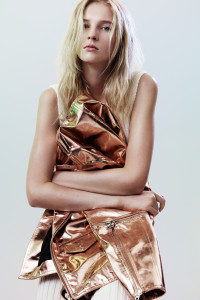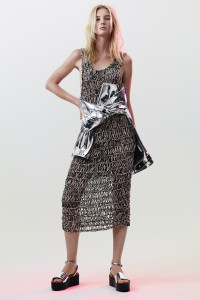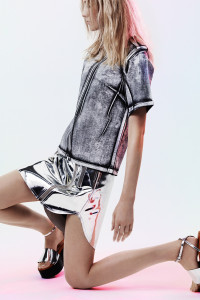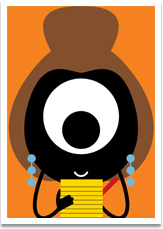McQ at London Fashion Week Day One
London Fashion Week has opened with a revelation. It is not the latest designer-genius spawned by one of the powerful British art colleges – although that still might come.
Nor is it a show put on in the inimitable, crazy way for which London is renowned.
Instead, my epiphany came from a line-up of worn metallic stepladders and a bunch of used cardboard delivery boxes from China.
With these simple tools, McQ, the more accessible line from Alexander McQueen, displayed its collection for Summer 2015.
I saw immediately that designer Sarah Burton and her team had produced urgent, desirable, easy-to-wear and easy-on-the-wallet clothes that fit with Lee McQueen‘s original, powerfully creative attitude.
There were patent-leather jackets burnished with metal to make them glow silver or pink gold. Jeans were treated with foil to iron-in sun-bleached creases.
Taking on a theme of ‘California Dreaming’ – the dark side – tailored jackets were blasted with circular rivets and crumpled as if dredged from the ocean floor. Another look from McQ’s drowned world was industrial-sized fishnets used for mesh dresses.
T-shirts had manga-style patterns or a comic strip with a suitably witty slogan: ‘Teenage Torpor’.
As for the Chinese cartons, Andy Rogers, McQ’s brand director, used the cardboard to display accessories (think of python bags spiced with orange and green) because Kering, the brand’s parent company, insists on its labels making an ‘E’ for effort with ethical fashion.
During this collection, presented on the first day of the London shows, I realised why it is imperative for the (mostly foreign) fashion conglomerates to invest in young British talents – so, clearly people who are striving to build a complete brand.
This season the star creators include Burberry, of course, which, under Christopher Bailey – as combined chief creative and chief executive officer – has developed the brand into so many areas.
Then there is Christopher Kane – like McQueen a Kering protégé – who is at an earlier stage of strategic brand building. Meanwhile, Jonathan Anderson has been picked by LVMH to develop its Spanish Loewe brand, as well as the designer’s own.
The French luxury giant is also mentoring Thomas Tait, who won the first LVMH Prize for young designers, an initiative under the auspices of Delphine Arnault, daughter of the multinational’s chairman and chief executive officer, Bernard Arnault.
With 300,000 euros and a year’s mentoring, the Montreal-born, Central Saint Martin’s-educated and London-based Tait will do more than make a splash with his artistic project at Monday’s show. He also expects to take his first major steps towards brand development.
Unlike some of my colleagues, I think it is a fine thing that the industry giants are now prepared to help pay for the building blocks to international success.
I have seen too many British designers explode onto the fashion scene, rise to glory – but never turn their talents into a buck. That sad course was taken by Ossie Clark, the wunderkind of the 1960s, whose clothes still resonate today, but who was never able to build a viable business.
Lee McQueen could have been another of those fiery spirits who burnt out – well before his untimely death. Instead, his spirit lives on in his eponymous collection and in McQ, which was founded in 2006.
Lee played off LVMH so skilfully, and the then PPR (now Kering), that I like to think of him gazing benignly down on a collection that does him justice, and offers to a wide, global audience something great to wear.





